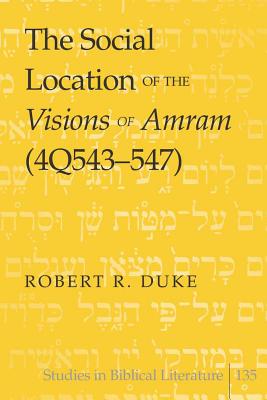The Visions of Amram (4Q543-547), five copies of an Aramaic text found among the Dead Sea Scrolls, stems from the pre-Hasmonean period and provides evidence of a highly variegated society in early Judaism. In this book, Robert R. Duke offers a new reading of all the fragments and an in-depth discussion of their significance, illuminating a time period in Jewish history that needs more understanding and culminating in a suggested social location for its production. Duke concludes that 4Q543-547 was written by a disenfranchised group of priests who resided in Hebron. The importance of the patriarchal burials, chronology, endogamy, the figure of Moses, and angelology argue for a priestly group, whose members were also influenced by apocalyptic thinking. The suggestion of Hebron as the geographical location for this group is based on the theories of George Nickelsburg's and David Suter's work on 1 Enoch. Pre-Hasmonean Judaism was an intense time of dialogue and disagreement, and 4Q543-547 is one more item to consider in reconstructing these social realities.
| FindBook |
有 1 項符合
The Social Location of the Visions of Amram (4q543-547)的圖書 |
 |
The Social Location of the Visions of Amram (4q543-547) 作者:Duke 出版社:Peter Lang Inc., International Academic Publi 出版日期:2010-08-06 語言:英文 規格:精裝 / 174頁 / 普通級 |
| 圖書館借閱 |
| 國家圖書館 | 全國圖書書目資訊網 | 國立公共資訊圖書館 | 電子書服務平台 | MetaCat 跨館整合查詢 |
| 臺北市立圖書館 | 新北市立圖書館 | 基隆市公共圖書館 | 桃園市立圖書館 | 新竹縣公共圖書館 |
| 苗栗縣立圖書館 | 臺中市立圖書館 | 彰化縣公共圖書館 | 南投縣文化局 | 雲林縣公共圖書館 |
| 嘉義縣圖書館 | 臺南市立圖書館 | 高雄市立圖書館 | 屏東縣公共圖書館 | 宜蘭縣公共圖書館 |
| 花蓮縣文化局 | 臺東縣文化處 |
|
|
圖書介紹 - 資料來源:博客來 評分:
圖書名稱:The Social Location of the Visions of Amram (4q543-547)
內容簡介
作者簡介
Robert R. Duke, received his PhD in Near Eastern languages and cultures from the University of California, Los Angeles. He is currently Assistant Professor in the Division of Religion and Philosophy at Azusa Pacific University. During the 2000-2001 academic year, a Rotary Ambassadorial Scholarship made it possible for him to study at Hebrew University, and in 2005 he was a Fellow at the Albright Institute for Archaeological Research. His research interests include Second Temple Judaism and the Dead Sea Scrolls. He is also interested in ways to incorporate community-engaged pedagogical practices in the field of biblical studies.
The Dynamics of Early Judaean Law: Studies in the Diversity of Ancient Social and Communal Legislation
The Composition of Luke and Rewritten Scripture
The Composition of Sūrat Maryam: Rhetorical Analysis
Muslim Mobilities: Geographies of Piety and Belonging in Tajik Dubai Business
Jousting with John: Essays on Jews, Gender, and Ethics in the Fourth Gospel
Jewish Manuscripts, Prayers and Scholars: An Anthology of Historical, Linguistic and Liturgical Essays
Sermons on the Final Verses of the Song of Songs: Volume III
How to Know the Difference Between True and False Prophets Study Guide
The Spirit, New Creation, and Christian Identity: Towards a Pneumatological Reading of Galatians 3:1-6:17
Luke’s Demonstration to Theophilus: The Gospel and the Acts of the Apostles According to Codex Bezae
The Composition of Luke and Rewritten Scripture
The Composition of Sūrat Maryam: Rhetorical Analysis
Muslim Mobilities: Geographies of Piety and Belonging in Tajik Dubai Business
Jousting with John: Essays on Jews, Gender, and Ethics in the Fourth Gospel
Jewish Manuscripts, Prayers and Scholars: An Anthology of Historical, Linguistic and Liturgical Essays
Sermons on the Final Verses of the Song of Songs: Volume III
How to Know the Difference Between True and False Prophets Study Guide
The Spirit, New Creation, and Christian Identity: Towards a Pneumatological Reading of Galatians 3:1-6:17
Luke’s Demonstration to Theophilus: The Gospel and the Acts of the Apostles According to Codex Bezae
|






![塔木德:猶太人的致富聖經[修訂版]:1000多年來帶領猶太人快速累積財富的神祕經典 塔木德:猶太人的致富聖經[修訂版]:1000多年來帶領猶太人快速累積財富的神祕經典](https://media.taaze.tw/showLargeImage.html?sc=11100697818)




